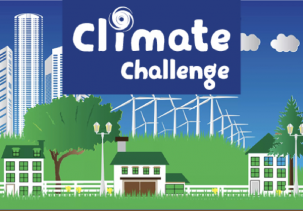Interactive Quiz: Test Your Knowledge of Climate Change and Its Impacts
In celebration of Climate Week NYC, here are 10 sample questions from our Climate Challenge game on Kahoot!

How much do you know about climate change, its effects on our oceans, our communities, our food and our health? It is difficult to imagine not having faced this question numerous times over the ten years since the initiation of the New York City Climate Week as part of the UN General Assembly Meeting.
Climate Week NYC (from September 24-30 this year) has been expanding the conversation and driving climate action forward since its launch in 2009. The event provides a key opportunity for climate conversations both at an international level and a local level through partnerships with businesses, the arts, academia and local government. In 2017, Climate Week reached an estimated 535 million people globally. Each individual adds a critical voice to the conversation.
But here is the interesting part: aside from these important meetings and focused opportunities to discuss and explore climate change, the ‘spiral of silence’ reported by the Yale program on climate change communication in 2016 persists—most individuals continue to shy away from talking about climate change with friends and family. Although people regularly discuss topics that explore differing ideas and raise controversy, such as the economy, politics and religious beliefs, conversations on climate change continue to be avoided. So how can we spark conversations and share critical information about how climate is affecting both rural and urban communities, our ecosystems, our energy and transportation, our polar regions?
We need to think of creative opportunities and unique approaches to share information that can help to start the conversation. So Columbia’s PoLAR program formed a partnership with NOAA and Kahoot! to introduce climate in a unique way to students as well as adults at gatherings and festivals. We are hosting a Climate Challenge through a set of 10 quizzes, each with about a dozen questions, that dive into different areas of the National Climate Assessment. Scroll below to see a sample of our climate questions.
Kahoot! is an educational and social media platform with over 70 million users, including 47 percent of US teachers, with over 50 percent of all students using it each month. Since our launch in early September, 450,000 players have accepted our Climate Challenge, completing at least one kahoot quiz.
As part of Climate Week NYC, we challenge you! We pulled a sample question from each area for you to test your climate knowledge.
Climate Change Quiz
Which of the following is an example of climate?
An intense thunderstorm in Houston
The average temperature in Chicago over the past 50 years
A hot day in Boston in the fall
A foggy day in San Francisco
How are warming ocean temperatures impacting whales, fish, & other marine mammals?
They aren’t as hungry because it’s so hot
Warmer water makes them sleepy
Their migratory patterns are changing
Summer seems longer so fish are schooling less
How can extreme events like hurricanes, drought, & wildfires impact energy infrastructure?
Water shortages
Power outages
Higher electricity & gas prices
All answer choices are accurate
Cities & rural communities face some of the same climate issues; these include:
Too many people with the same name slows emergency response
There are not enough celebrities focused on climate issues
The need to upgrade aging infrastructure
People can’t identify the needed solutions so take no action
How is climate change altering precipitation in the U.S.?
Increasing extreme precipitation everywhere
Increasing length of droughts everywhere
Increase in both wet and dry extremes
Climate change doesn’t alter precipitation
How do climate factors (temperature, precipitation, & humidity) relate to vector-borne disease?
Heavy rain increases the risk of animals transmitting rabies
Milder winters increase the tick density & risk of lyme
Dry summers & drought increase the risk of West Nile virus
Snow storms increase mosquito density & risk of malaria
Why are forests important for mitigating climate change?
Forests serve as a sink in the carbon cycle
Trees provide building materials
Trees are an important food source
Leaves of trees reflect all sunlight away from the Earth
An important example of a “positive feedback loop” in the polar climate system is:
Scientists in remote places check on each others instruments
Warming ocean water opens new areas for marine species
Warmer winters cause more plant growth, providing more food
Sea ice melt opens more ocean to sunlight, causing more melt
Of the following, the most impactful action you can take to reduce your carbon footprint is:
Turn off your lights more often
Drive a hybrid car
Eat a plant-based diet
Hang your clothes to dry
2,3,4,3,3,2,1,4,3
Want More?
This week we have a chance to really focus on a critically important question area for all of us: What can we do about climate change? As part of Climate Week, we have set up a separate challenge for this topic. Download the Kahoot! app, click play and enter PIN #0157979 to play the quiz. Challenge yourself on this topic and see how you stack up against others!
Be sure to check out all our climate kahoots.
Other online climate items to explore:
How do your views on climate change stack up against the rest of the country’s? You can find out by answering these four questions on Yale’s Six Americas survey.
One of the impacts of a warming climate that will affect our coastal communities is sea level rise. Explore the causes and impacts in our new online version of the Polar Explorer: Sea Level.
